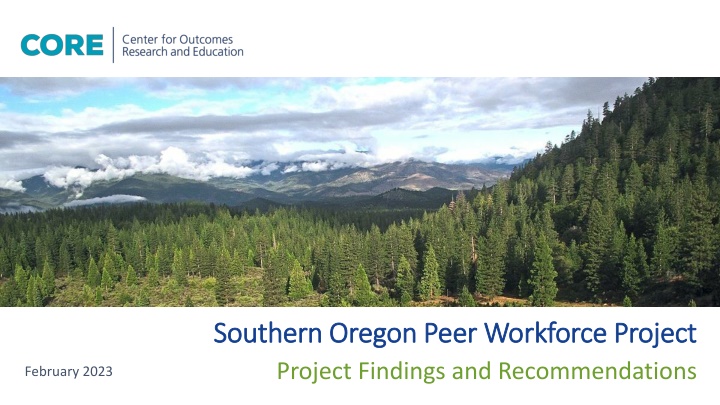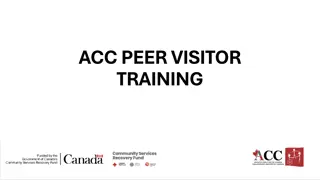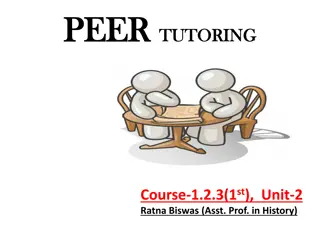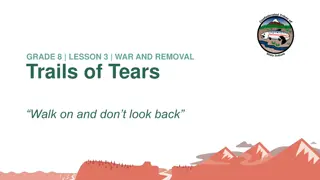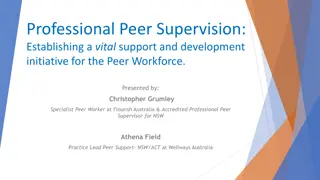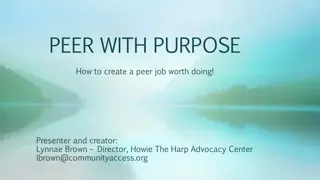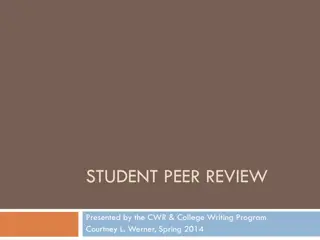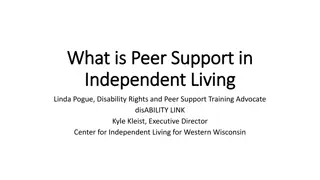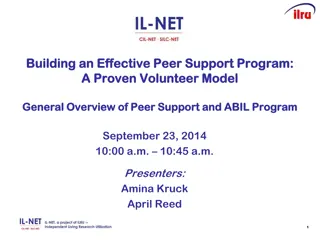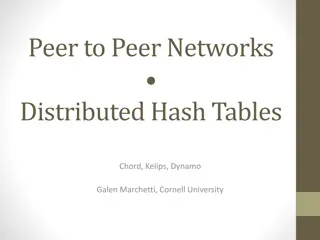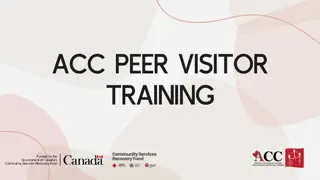Southern Oregon Peer Workforce Project Findings and Recommendations
The Southern Oregon Peer Workforce Project conducted research to enhance peer training and supervision programs. The project aimed to foster shared learning among peer support services in Southern Oregon, leading to improved advocacy and evaluation capabilities. The findings and recommendations from the project in February 2023 highlight the importance of collaboration and innovation in peer workforce development.
Download Presentation

Please find below an Image/Link to download the presentation.
The content on the website is provided AS IS for your information and personal use only. It may not be sold, licensed, or shared on other websites without obtaining consent from the author.If you encounter any issues during the download, it is possible that the publisher has removed the file from their server.
You are allowed to download the files provided on this website for personal or commercial use, subject to the condition that they are used lawfully. All files are the property of their respective owners.
The content on the website is provided AS IS for your information and personal use only. It may not be sold, licensed, or shared on other websites without obtaining consent from the author.
E N D
Presentation Transcript
Southern Oregon Peer Workforce Project Southern Oregon Peer Workforce Project Project Findings and Recommendations February 2023
Agenda Introductions (in the chat!) Project Background Findings and Bright Spots Recommendations Areas for Continued Work Project Tools Q&A
About CORE 30+ scientists, researchers, and data experts with a vision for a brighter future. An independent team based in Portland, Oregon within the Providence Health System Our Mission: To drive meaningful improvements in health and health equity through collaborative research, evaluation, analytics, and strategic consulting. Our Goal: We work to inform and inspire a healthier, more equitable world!
Acknowledgements This project would not have been possible without the support from: The peers and peer supervisors who participated in our discussions, interviews, & focus groups Our Project Advisory Team: Peter Buckley, Southern Oregon Success Shaunte Duron, THW Liaison AllCare, PSS Cliff Juno, THW Liaison Jackson Care Connect Adrienne Scavera, Mental Health Association of Oregon Southern Oregon Peer Support Specialist Community of Practice Behavioral Health Workforce workgroup facilitated by Southern Oregon Success We are grateful to everyone working across the region in peer support and to all the members of the peer community. We are appreciative of the incredible work you do each day.
Southern Oregon Peer Workforce Project Background In 2022 CORE was funded to collaborate with interested parties in the region to elevate learnings and recommendations for peer training and peer supervision & support. Shared learning across peer programs A primary objective of this project was to cultivate shared understanding among peer support services in Southern Oregon (So. OR) to facilitate: Increased ability to advocate for funding and workforce improvements Strengthened capacity to evaluate what is working within and across peer programs
Project Methods and Activities INTERVIEWS & FOCUS GROUPS 13 virtual informal interviews with peer supervisors working in So. OR. and three in- person focus groups in Medford, OR with 13 peers from 7 agencies. CONSULTATION with peers, and other BH/SUD leaders in Southern Oregon guided the direction, methods and analysis, and shaped the final products of this project. EVIDENCE & DATA REVIEW Summary of recent literature about the effectiveness of peer models & a data review of information on S. OR peer programs.
What do we mean by the peer workforce For this project we defined peers as individuals who have lived experience and additional training to support others experiencing similar challenges with mental health conditions, substance use disorders, or both. Peers included within this definition fell into four types/focus areas: Adult Addictions/Recovery Adult Mental Health Family Support Youth Support In So. OR Common Titles Include: Peer Support Specialist Certified Recovery Mentor Peer Mentor Family/Youth Mentor Family/Youth Support Specialist Peer Facilitator/Coach
Southern Oregon Peer Workforce Overview Peer organizations participating in this project: Employed a total of 110 peers as of June 2022 59% of these peers worked in SUD 75% of employers starting wage was less than $19/hour or $39,520 annual salary Concentration of peer delivered services within population dense counties Behavioral health peer services had more uniform coverage across the region compared to substance use disorder and family/youth services. 50% of organizations reported having a peer in direct supervisor roles Participating Organizations service delivery area (Organizations that serve multiple counties are counted for each county they work in).
Southern Oregons Peer Workforce is Experiencing Rapid Growth The number of organizations hiring peers has seen steady growth over the last decade. In June 2022 Peer Employers had plans and confirmed funding to fill an additional 31 peer positions by the end of the year, representing a 28% increase in peer positions in the region within 6 months.
Main Highlights Peer Training & Certification Supervision & Support Professional Development & Career Pathways Evidence Review Additional Priorities for Peer Services
Key Finding: Peer-Specific Infrastructure Requires an Authentic Understanding of the Peer Model A central theme from our conversations is that the peer support model s power to heal and empower people is grounded in shared experience and mutuality. As organizations continue to expand peer services, it is critical to do so with an authentic understanding of the peer model and Peer-specific workforce infrastructure. Peer-specific workforce infrastructure includes approaches, standards, practices, and investments that are grounded in a clear understanding of: o What the peer role is (and what it is not) o Recovery-oriented values, practice, and culture
Evidence Review Key Takeaways: Outcomes & Evidence Evidence of clinical outcomes There is strong evidence to support the impact of peer-delivered services on the following clinical outcomes: Evidence of social outcomes There is strong evidence to support the impact of peer-delivered services on the following social/psychosocial outcomes: Reduced hospitalization/rehospitalization Reduced substance use Increased engagement with treatment & services Increased quality of life (QOL) Increased hope and empowerment Increased social support Limited studies disaggregate outcomes and experiences by race/ethnicity, language, sexual orientation, and gender Gaps exist in the research on culturally specific peer-delivered services and models More attention to the specifics of implementation for peer-delivered services Standardize measurement and use consistent scales to measure outcomes Include more detailed definitions of peer-delivered services and clarify peer roles and responsibilities in interventions Limited research into economic outcomes related to the cost-effectiveness of peer- delivered services in varied settings Literature Gaps & Areas for Future Research
Peer Training & Certification
Peer Training & Certification Findings Certifying peers through state-approved programs has become standard practice in the region. The 40-hour Peer Support Specialist/Certified Recovery Mentor certification training is a useful introduction to the peer role but is not sufficient to prepare peers for their day-to-day work with clients. Peers desire advanced and supplemental trainings that are designed specifically for the peer role. There is a wide range of organizational infrastructure, training budgets, and onboarding practices in the region.
Peer Training & Certification Quotes It just seems like 40 hours isn't enough to go through really thoroughly, HIPAA and some of the important pieces and I almost wish it was a little bit longer or that maybe they had boosters. You know, you do your 40 hours and then every quarter maybe a booster... I guess it's just, wow, sending a peer out with a client after 40 hours of training when anything could happen." Peer Supervisor I think that more training specific to peers would be really beneficial. It could be specific to the way that we document things, the way that we work with peers, the way that we help them, setting boundaries, just more peer- specific focused training. Peer Employee Unfortunately for peer staff, I don't think there's really any assistance with training dollars, so that is a gap that I wanna see if we can't address. I think there is some inequity in the way things are set up. Peer Supervisor
Peer Training & Certification Bright Spots Family Nurturing Center: relatively structured onboarding process; dedicated time with peer supervisor; shadowing; support from IT department for computer skill development. Options: Dedicated funding for peer trainings; sends ALL peer staff to Peerpocolypse in Seaside, OR each year. Pathfinder Network: Robust training offerings have supported peers to feel confident; offer skills training in regulation and strength-based approaches.
Supervision & Support
Supervision and Support Findings Peer supervision practices and standards vary widely across organizations in So. OR. The peer role is unique and requires supervision practices that acknowledge the full impact of a peer's day to day work. Peers and supervisors agree that there are organizational and supervision practices that are most effective to support peers. Peer supervisors need ample onboarding and training themselves, along with organizational support, to be able to provide adequate supervision to employees.
Supervision and Support Quotes "We talk as a senior management team about just like they [peers] are in the most vulnerable role in this agency because they don't just get to come to work and leave their personal life to the side. It's part of their job. It's part of what we're asking them to do. Peer Supervisor I need to be a peer to supervise a peer And then being familiar with like core competencies for peer work, knowing what peer work is, knowing the resources that are available, being familiar with the resources. And then being approachable and just being another member of my team, you know, managing with them, not above them, you know. Peer Supervisor I've been in this role for almost three years as a peer supervisor, so along the way I have gathered enough training that I feel more equipped now than I did when I first started, but it's been a long trek, [it] wasn't all at the onset. So, I think having a training at the beginning like a virtual webinar or interactive training, anything around supervision a training that was specific to the job functions would be helpful and especially as a peer supervisor. Peer Supervisor
Supervision and Support Bright Spots Family Nurturing Center: 1 hour of reflective individual supervision each week; uses the sanctuary model (Sanctuary Model Sanctuary Institute). Addictions Recovery Center: Offers 4 day/32-hour work week HIV Alliance: Self-care 1st model Kairos: Going Above and Beyond (GAB) awards; staff bonuses; both help with retention OnTrack: Provides two Mental Health days Jackson County Mental Health: Flexible schedules for peers to work fulltime or part-time
Professional Development & Career Pathways
Professional Development and Career Pathways Findings There is limited upward mobility for peers. Organizations are increasingly recognizing the value of developing advanced peer positions and hiring peers as supervisors. Peers want career pathway options that will allow them to advance their career while remaining in the peer role.
Professional Development and Career Pathways Quotes Well, I've been a parent mentor for six years, so certified recovery mentor and peer support specialist. I graduated with a behavioral science degree in March. I said I'd really like to advance and be a manager. I want to supervise the parent mentor team... I'd really like to grow and climb the ladder and they gave me that. It all happened at a perfect moment because Measure 110 money was coming in and we were able to start a new program to where I was able to go and be a supervisor. Peer Employee For me, I like what I do, and I feel like I do have a lot of the experience piece of it because I went from being a person with an addiction to a person in recovery to an employee. I like what I do, and I don't ever want to be a CADC. I don't have any desire to be a CADC. I like what I do, I like being down here on the ground level with them and being able to be that support person that they can come to and relate to instead of this person that's on a pedestal. Peer Employee
Professional Development & Career Pathways Bright Spots Addictions Recovery Center: Provides a career path for peer role; opened peer supervisor and peer manager positions; provide career wages/competitive wages. Kairos: Offers levels of peer tiers; increased pay grades at each level. Oasis Center of the Rogue Valley: Supportive of peer employee s career development; Creates space for peer employee growth.
Recommendations* *Recommendations elevated and vetted by peers and peer supervisors
Recommendations: Organizational Professional Development and Career Pathways Peer Training & Certification Supervision and Support Develop enhanced onboarding protocols to support peers entering the workforce Hire and Promote peers into supervision and management positions Increase opportunities for growth and leadership within the peer role that are aligned with individual peer employee s goals. Dedicate funding and organizational budgeting specifically for supplemental trainings Provide more extensive training and onboarding support for peer supervisors Link peers to training or skill development for future roles as supervisors/managers Cultivate a general culture of support for professional development and continuous learning Ensure that supervisors on staff have time and encouragement to meet individually with each of their peer reports at minimum 1x/month Educate leadership and other decision-makers within the organization about the peer role and scope of practice
Recommendations: Regional Professional Development and Career Pathways Peer Training & Certification Supervision and Support Expand access to and promotion of trainings such as Crisis Prevention, Medically Assisted Treatment, Mental Health Awareness/Mental Health First Aid and ASIST Support access to supervision training for peer organizations across the region Consider the creation of regional standards for tiered peer roles with salary increases for each tier (e.g., Peer I, Peer II, Peer III, Lead Peer, Peer Supervisor or Manager) Encourage direct supervision by peers themselves and/or co-supervision models so that all peers have access to supervisors have experiential knowledge of peer services. Support the development of a Smart & Safe documentation training to help peers across organizations learn tips to be efficient and protect themselves and their clients Funders should include sufficient funding and explicit budget line items for supervision within grants and contracts for peer services. Support access to culturally specific Spanish language peer certification Provide more support and clear pathway for peers to become trainers/facilitators of peer trainings
Additional Priorities for Peer Services: Culturally & Linguistically Responsive Peer Services Most organizations acknowledged that their current service delivery model does not adequately support Black, Latinx, Native American, LGBTQIA2S+, Asian, Pacific Islander, or disabled clients. Interpretive services, even when appropriately accessed (and this was a challenge), are not ideal for peer services which are inherently relational and rely on connection and trust. These are both harder and slower to establish with interpretation (especially in group settings). Many organizations described challenges hiring Spanish-speaking peers and half of the participating peer programs did not have any Spanish speaking peers on their team. Peers underscored the importance of having culturally diverse staff at all levels of the organization including supervision and leadership
Areas For Continued Work: Culturally Responsive Peer Services Southern Oregon has a huge Hispanic population. We don't have any mentors currently that are bilingual. I've been able to work with one dad who was undocumented. He spoke broken English, and I was able to work with him .if he didn't speak any English, there would've been a huge gap there and a big barrier. I was trying to learn with Google Translate a little bit. I was asking my phone, "Say this." We need more representation for our Hispanic community. Peer Employee I m going to be blunt, but you have white folks making decisions for Latino folks, and they have no idea how our community works. If you have Native Americans, you need to have your people in charge, people that are Native Americans to implement those programs. Peer Employee
Culturally & Linguistically Responsive Bright Spots Reclaiming Lives Recovery Cafe recently launched a culturally specific Latinx Caf with support from AllCare CCO. They also have a LGBTQIA+ circle. Kairos hosts twice monthly DEI trainings/forums called Empower Hour for their entire agency. Supervisors are working on integrating learnings from these conversations into their supervision practice and reflection within their conception of trauma-informed care.
Areas For Continued Work: Collaboration & Coordination of Services Peers and supervisors both expressed a need for increased understanding of the current service array and available resources for their clients, acknowledging that stronger connections between service providers help support referrals and care coordination between multiple organizations who may be serving the same clients. Lack of communication and coordination sometimes leads to duplication of efforts or resources COVID-19 has impacted peer organizations ability to effectively collaborate and coordinate. Over the past few years, many resources and organizations have shifted a lot in the region, and some have closed entirely. Some of these Zoom meetings, there's so many of them - different committees to be a part of and things like that. Sometimes I have the time and sometimes I don't, but they're these agenda meetings and they're not actually about building relationships across community resources. I think that's super crucial for me to be providing the best care I possibly can to my clients. To know what the heck [X Organization] is so that I can properly refer them there or not refer them there, depending on what is going on. It's a lot of stuff to do without having that already built in. Peer Employee
Collaboration & Coordination Bright Spots Addictions Recovery Center (ARC) has strong collaborations with Medford Livability Team and the Community Homeless Outreach Project. They also have regular meetings with law enforcement agencies and coordinate planned releases from jail so that ARC staff can connect with folks as they are released. Oasis Center of the Rogue Valley subleases part of its building to other organizations who offer complimentary services. They are currently working to open a childcare program in 2023. Peer Community of Practice: The monthly Peer Community of Practice provides monthly opportunities for peers from across the region to gather, network, and learn together.
Southern Oregon Peer Workforce Project Tools: How to use the findings from this project to advance peer workforce development
Project Products- Evidence Review What is it: A summary of current evidence around the impact of peer programs and services How to Use it: Advocate for peer workforce development, peer program expansions and/or financing Consider what outcomes or impacts to track in partnership with peers. Link to Evidence Review 37
Project Products- Project Report (with project overview and topic-specific briefs) What is it: Findings and recommendations (presented in a project overview & four briefs) and highlights of promising practices from organizations working with peers in the region (all linked below). Training and certification Supervision and support Professional development and career pathways Additional priorities for Peer services How to Use it: Use as a full report or share topic-specific briefs for a more focused conversation or initiative. Actionable recommendations to guide capacity building, strategic investments, and alignment with best practices. Link to full Project Report 38
Project Products- This Presentation What is it: Highlights important information from the report and information on how to access and use project products. How to Use it: Share findings and recommendations both internally within organizations or externally with partners, funders, etc Users can hide slides to curate the right information for their audience. 39
a Q&A Q&A
Connect with CORE Lizzie Fussell, MPH Program Manager Elizabeth.Fussell@providence.org Roxanne Marsillo, MA Research Associate Roxanne.Marsillo@providence.org Website: providenceoregon.org/CORE Blog: blog.providence.org/center-for-outcomes-research-education Sign up for our Newsletter: At our website Or email core@providence.org
